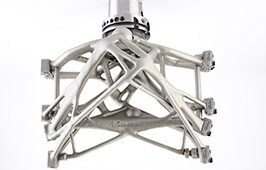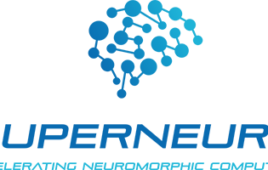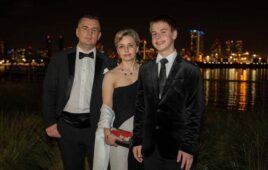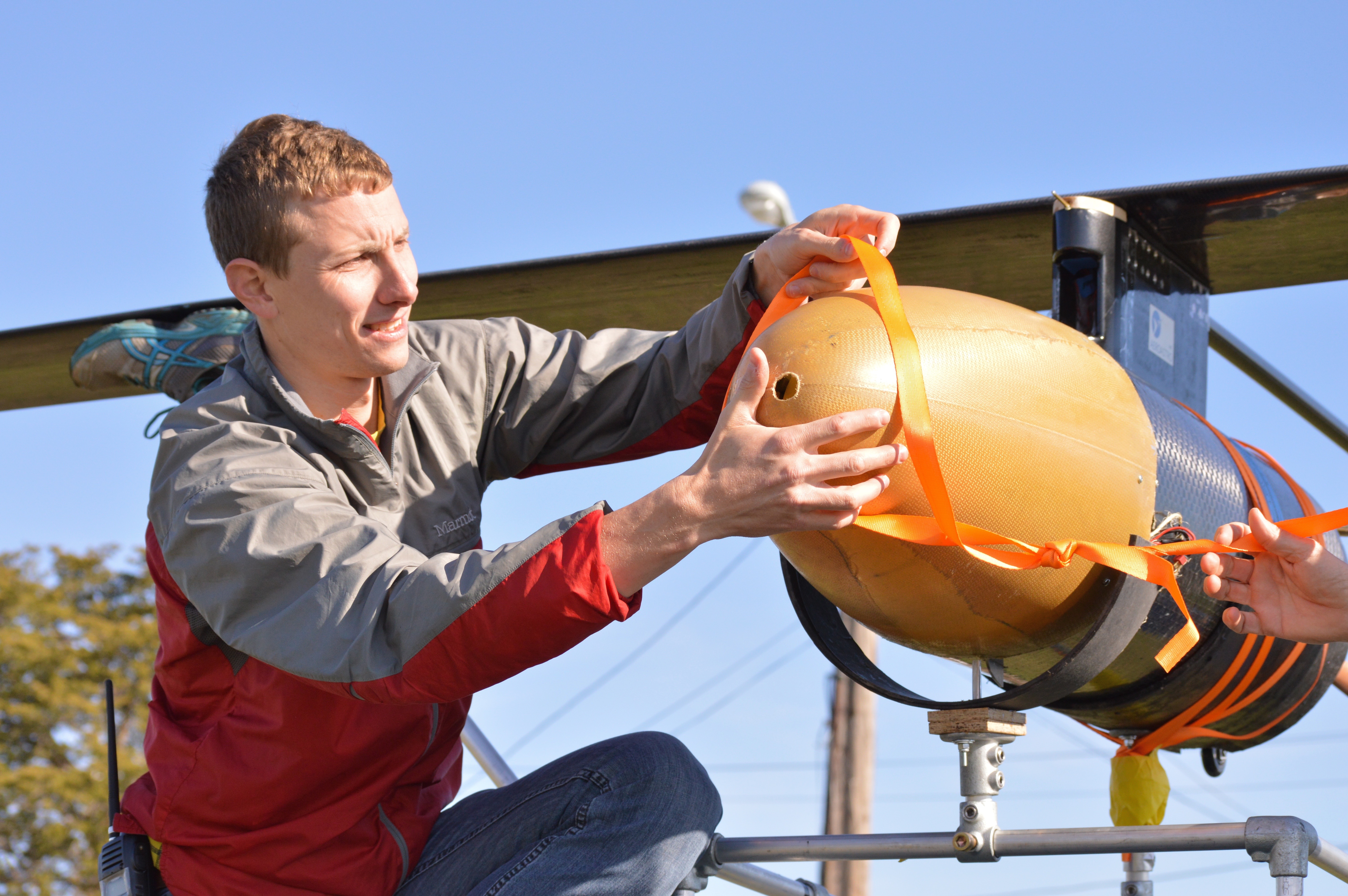
Photo courtesy of Warren Hoburg
Staying grounded has never been Warren “Woody” Hoburg’s style. As a teen, he built and launched large-scale rockets, the biggest reaching 21 feet tall and weighing more than 130 pounds. During his early twenties, he became an avid rock climber and skydiver and at 26, he got his private pilot’s license. Despite these interests, it has always been the process, not the danger, that attracts Hoburg to these sky-high activities.
“For me I really enjoy taking the time to get everything right,” said Hoburg, who went on to become an Assistant Professor of Aeronautics and Astronautics at Massachusetts Institute of Technology (MIT) in 2014. “I enjoy the prep part as much as the actual activity, just making sure that everything is safe and no one is going to get hurt.”
This dedication to accuracy and preparation eventually led Hoburg and his team at MIT to create the Jungle Hawk Owl flight drone— a gasoline- powered, inexpensive, unmanned aerial vehicle (UAV) designed to stay aloft at 15,000 feet for more than five days. For months before they even began to construct the aircraft, Hoburg and his team performed significant modeling using GPkit, a software tool developed by Hoburg that allows around 200 constraints and physical models to be considered simultaneously, ensuring the optimal aircraft design. Due to this level of modeling and preparation, the team’s very first prototype successfully flew in May 2017 during their first test.
Hoburg—who was chosen as R&D Magazine’s 2017 Innovator of the Year for this achievement—is now taking his sights even higher—literally. The 31-year-old Pittsburgh, Pennsylvania native was recently selected by NASA to join the 2017 Astronaut Candidate Class. He reported for duty in August 2017 to begin two years of training as an Astronaut Candidate.
Early inspirations
Hoburg cites his childhood amateur rocketry hobby as his “single biggest inspiration” to pursue aerospace engineering.
He began as a casual hobbyist, building rockets from kits sold at hobby stores. It was when he discovered the Pittsburgh chapter of the Tripoli Rocketry Association—a group dedicated to the advancement and operation of amateur high power rocketry—that his lifelong passion for aerospace engineering really took off.
“I went to one of their events and saw people building rockets that were 10 feet tall, which at the time seemed really large to me, although ultimately I went on to build even bigger rockets,” said Hoburg in an interview with R&D Magazine. “I met a lot of amazing, interesting people and was inspired by what they were doing.”
Although at 15 he was one of the younger members of the group, he quickly advanced to building bigger and bigger rockets and attending national launches.
His parents, Jim and Peggy Hoburg, were very supportive, allowing him to set up a rocket building shop in their garage and driving him to dozens of launch events before he was old enough to drive himself.
Several older members of the Tripoli Rocketry Association became mentors to Hoburg, and he is still in touch with them today.
“They really showed me the ropes through the hobby,” said Hoburg. “They got me from what was really a fun hobby to a more serious level.”
After high school, Hoburg went on to enroll in MIT, where he interned at the NASA Jet Propulsion Laboratory for the Mars Science Laboratory Rover team and at Boeing Phantom Works on the A160 Hummingbird Autonomous Helicopter team. He graduated with a Bachelor of Science in Aerospace Engineering in 2008.
He moved to the University of California, Berkeley for his advanced degrees, completing both a Master of Science and a PhD in Electrical Engineering and Computer Science at the university.
While completing his PhD thesis on formulating optimization problems for aircraft design, Hoburg worked summers on the Yosemite Search and Rescue team at Yosemite National Park, a position that had a big impact on him.
“Working search and rescue was an amazing experience,” said Hoburg.
He secured his position at MIT after completing his PhD in 2013, but opted to take a year in between graduation and beginning his academic career to work in industry. MIT was supportive of this decision, said Hoburg.
“The MIT Department of Aeronautics and Astronautics has historically been really supportive of young faculty members before they start their careers at MIT, going off and spending some time in industry, “he said. “I think that is unique to that department—in most academic roles you maybe do a post doc but you stay in academia. I was excited to go out and do something in industry and work on some real problems that a company wanted to solve.”
He took a position with Boeing Commercial Airplanes in Seattle, Washington, working on product development and applied math.
His role centered around composite manufacturing, specifically for the Boeing 787 Dreamliner. Hoburg’s group created novel software-based approaches to streamline and improve manufacturing, both the processes and also the flow of data from engineering to manufacturing.
“I spent a lot of time working on 787 fuselage frames, which are a cool part made out of composites. I got to see everything from the actual engineering design, to seeing how the part actually get fabricated, and everything that happens between the CAD model and the actual manufacturing floor,” said Hoburg. “It was a great experience to see some really tough problems that come up in a really new area of aircraft manufacturing.”
Following his year with Boeing, Hoburg received funding from the company to continue to work on composites manufacturing as part of his research at MIT.
“One of the most valuable things I learned was some of the real problems a big company like Boeing has, so I was able to tailor my research program to be better aligned to work on those things,” he said. “I gained a lot of perspective that was really valuable to setting the direction of my research group.”
Developing the GPkit
Creating a long endurance drone was not Hoburg’s initial plan for his research group. After working at Boeing he originally intended to focus on new optimization framework for designing airplanes—the topic of his PhD. It was this research that led him to create GPkit software, which is designed around the idea of convex optimization.
“There are some powerful types of optimization out there that can be solved efficiently—this is known as convex optimization,” explained Hoburg. “This is not generally the case. Most optimization problems that are well known in computer science are horribly difficult to solve, and this is known as NP-hard. These NP-hard problems show up all over the place, almost always if you have an optimization problem it is NP-hard and it is incredibly difficult to prove that you’ve found the best answer, arrived at a global optimum.”
Throughout the course of his PhD research, Hoburg discovered that there is a whole class of aircraft design optimization problems that can be formulated in a convex way and are therefore easier to solve. This is done using geometric programming (GP), a special kind of convex optimization.
“That is where I started as a young faculty member—this idea that we could use this powerful type of optimization to design airplanes,” said Hoburg.
He created GPkit software, which makes it easier to express an engineering design problem as a geometric program.
“We didn’t invent GP, it is a classic type of optimization that people have been studying for decades,” explains Hoburg. “It turns out that geometric programming, we believe, is really useful for engineering design problems and I think that is under recognized. GPkit makes it easy for engineers to formulate design problems as geometric problems and then solve them using the state-of-the art software for solving geometric problems.”
Although this software could be utilized for traditional airplane design, Hoburg quickly realized there was more opportunity in drone development.
“It turns out that commercial airliners don’t get designed that often,” said Hoburg. “A new commercial aircraft might come out every ten years at a place like Boeing. But drones are hot right now and there is a ton of activity designing new unmanned aircrafts and a huge number of commercial applications. We quickly figured out that we had some ideas that were powerful and would be useful for unmanned aircraft design.”
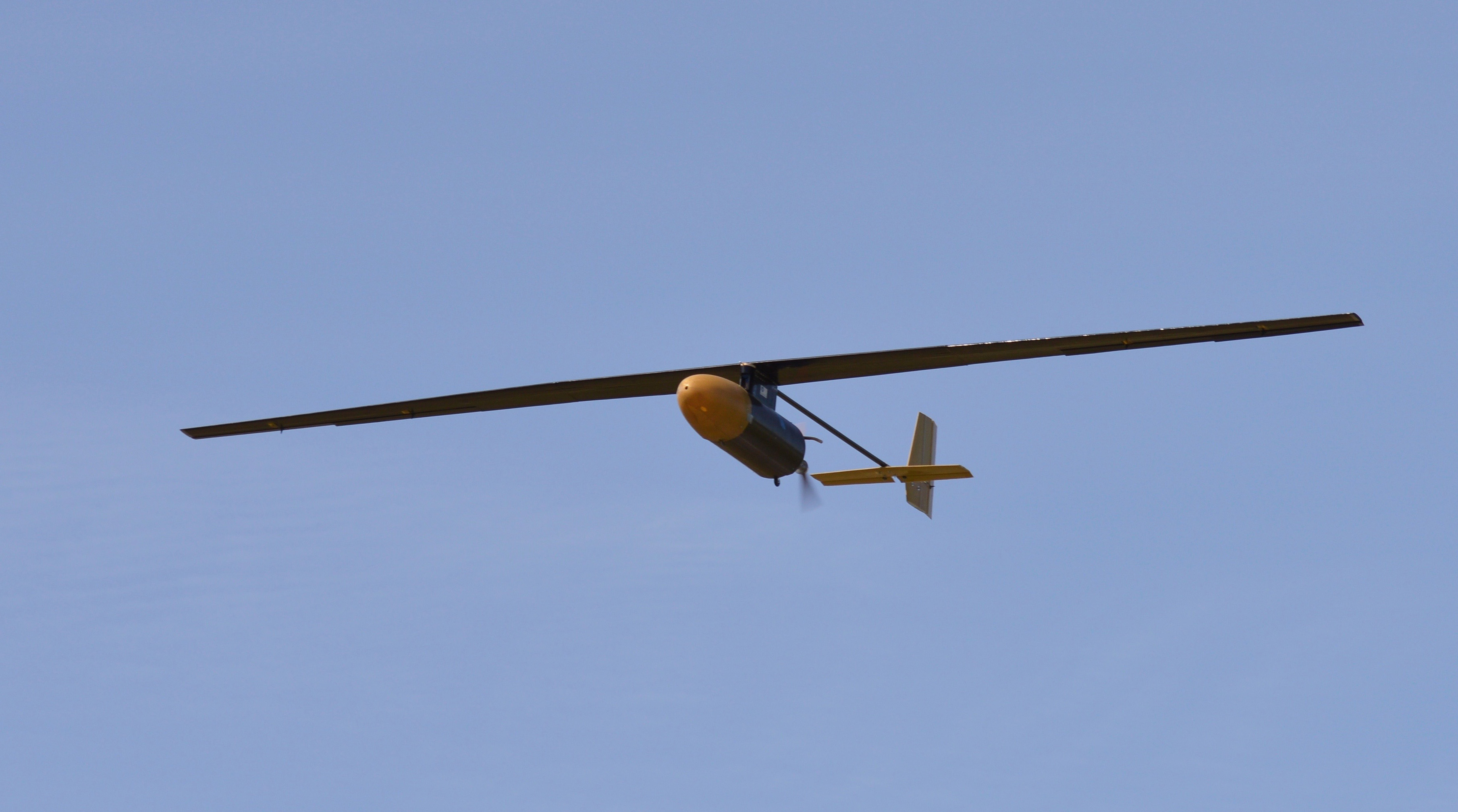
The Jungle Hawk Owl. Photo courtesy of Warren Hoburg
Building the Jungle Hawk Owl
MIT is a big proponent of project-based learning, and as a result students have the opportunity to work on real projects as part of their senior design projects. The Jungle Hawk Owl was a result of such a project, built entirely by MIT students and led by Hoburg and R. John Hansman, also a Professor of Aeronautics and Astronautics and Engineering Systems at MIT. The project began in early 2016 as a MIT Lincoln Laboratory Beaver Works Center capstone project—which is typically a two-or three-semester course that allows MIT students to design a vehicle that meets certain mission specifi cations, and to build and test their design.
Researchers at MIT Lincoln Laboratory were already working on lightweight communication payloads that had applications for disaster response, or responding to any emergency where communication infrastructure is not working properly. MIT Lincoln Laboratory had been launching the payloads, which are less than 10 pounds each, using weather balloons. This technique only resulted in a few hours of communication before the balloons would fl oat out of range.
With funding from the U.S. Air Force, Hoburg and his team of students partnered with MIT Lincoln Laboratory to create a better vehicle to carry the communication payloads. The goal was to create an aircraft that could autonomously carry the payloads up 15,000 feet—the height required for a clear pathway for the communication signal across a long range—and could continue to do so for up to five days.
Hoburg and his team’s initial thought was to create a solar-electric drone.
“It was the obvious solution,” said Hoburg. “It just seemed like five days of endurance would be too long to do it with gas power, we thought that we wouldn’t be able to carry enough fuel to make that happen.”
Hoburg, who considers himself environmentally conscious, loved the idea of building a solar powered drone. But his GPkit software indicated that this wasn’t the most efficient solution.
“We threw all of this into our optimization software, and we made really detailed models of both aircraft confi gurations— solar-electric and gasoline-powered options,” said Hoburg. “We modeled both of them in a lot of detail and very quickly, when we looked at the numbers, we realized that we had been wrong and gas powered was the obvious choice for this particular mission. So we scrapped our solar plans and went forward with the gas-powered and that turned into the Jungle Hawk Owl.”
Throughout the next 15 months, Hoburg and his team of students worked to plan the exact design of the Jungle Hawk Owl. Using the GPKit optimization software, they determined the best sizing of each part in order to keep the drone lightweight enough that it doesn’t require much fuel, but also powerful enough that it can maintain flight for five days.
“For the wing, the tail surfaces, the engine, the fuselage, for all of that it is not obvious how big that should be, and it’s really an optimization problem to get all of that right and working in harmony,” said Hoburg. “You might think, I will make the engine a little bit smaller that will burn less fuel, but then it might be underpowered, and another issue will occur. There is a balance on everything. If you pick the wrong size for something it is not well-matched and it may not be working efficiently with all the other components.” Using the optimization software, they entered in over 200 mathematical constraints that they knew needed to be true about the design.
“For example, we had basic aerodynamic models, so we knew how much drag was going to be on the aircraft during different phases of fl ight and what our fuel burn will be. We knew the tail boom needed to take the bending loads at the never-exceed speed of the airplane and we had a hard-over control input case to make sure that doesn’t break the tail off, and that sort of sizes the tail boom. There are hundreds of these constraints,” Hoburg explained.
They entered all of these constraints into the optimization software and tried out different objective functions—making the smallest drone possible, the lightest drone possible and the drone that burns the least amount of fuel.
In the fall of 2016, the team built a prototype drone following the dimensions determined by students using Hoburg’s software tool. To keep the vehicle lightweight, they used materials such as carbon fi ber for its wings and fuselage, and Kevlar for the tail and nosecone, which houses the payload. The researchers designed the UAV to be easily taken apart and stored in a FedEx box, to be shipped to any disaster region and quickly reassembled.
The drone itself weighs 50 pounds and requires only 15 gallons of fuel, which weighs 90 pounds. With the 10-pound communication payload, the total weight of the drone at takeoff is 150 pounds.
In the spring of 2017 the students refi ned the prototype and developed a launch system, fashioning a simple metal frame to fi t on a typical car roof rack. The drone sits atop the frame as a driver accelerates the launch vehicle (a car or truck) up to rotation speed—the drone’s optimal takeoff speed. At that point, the remote pilot would angle the drone toward the sky, automatically releasing a fastener and allowing the drone to lift off.
In early May, the team put the drone to the test and conducted fl ight tests at Plum Island Airport in Newburyport, Massachusetts.
For flight testing, the team had to modify the vehicle to comply with FAA regulations for small unpiloted aircraft, which allow drones fl ying at low altitude and weighing less than 55 pounds.
To reduce the UAV’s weight from 150 to under 55 pounds, the researchers simply loaded it with a smaller ballast payload and less gasoline.
In their initial tests, the drone successfully took off, fl ew around and landed safely.
“The flight vehicle that flew for the first flight was our first actual build of the entire airplane,” said Hoburg. “We didn’t make any full prototype prior to that, although we did prototype some subsystems. The first time we actually integrated everything into the actual fl ight vehicle, we actually flew that configuration.”
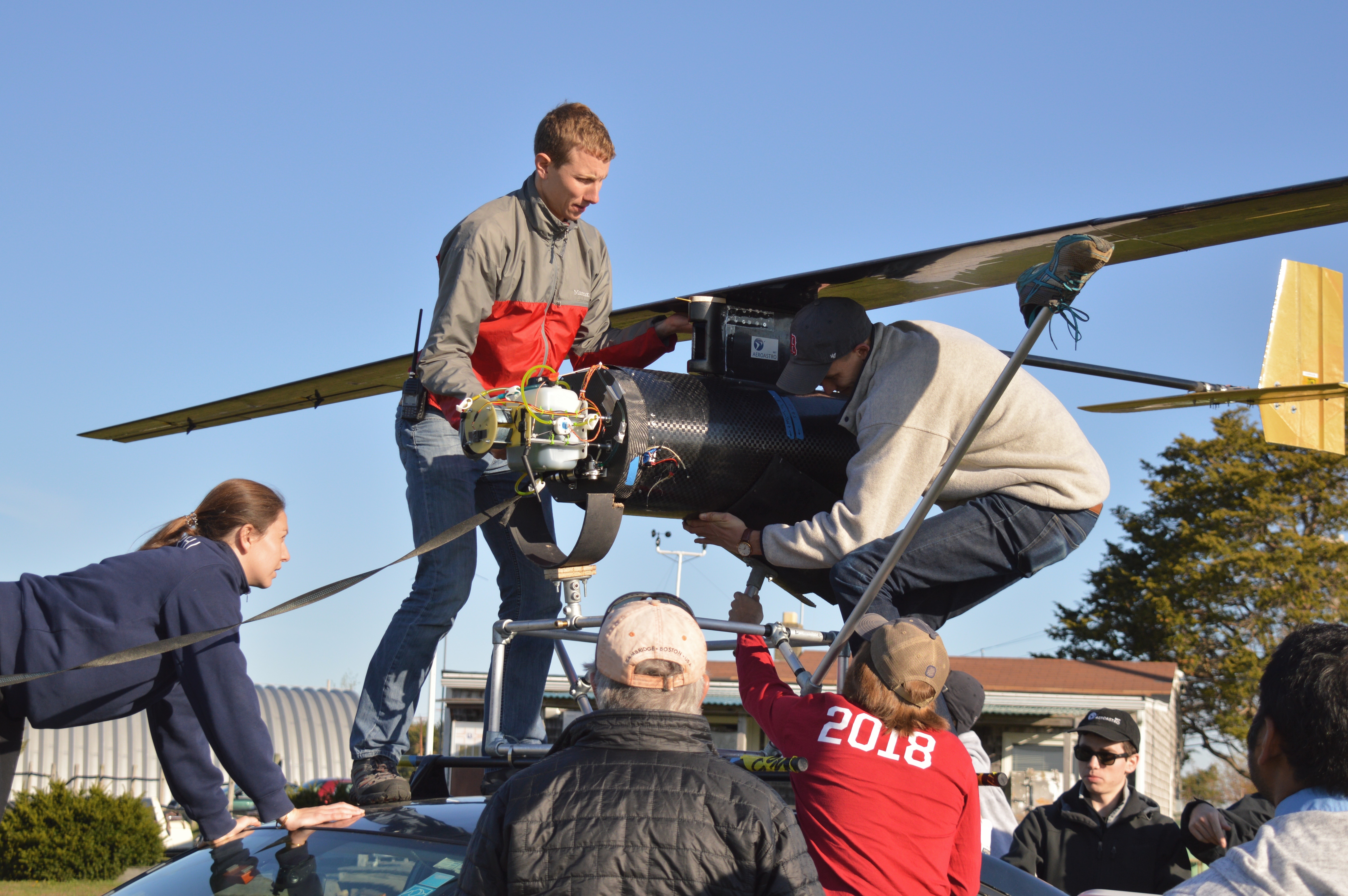
Photo courtesy of Warren Hoburg
Next steps for the drone
The drone has since been tested in the modified configuration more than ten times with success. However, due to FAA regulations, the team has still been unable to test their drone for the full five-day flight it was designed for. They are working to get the approvals to do so, and plan to do a full-scale test in the spring of 2018, most likely at a restricted military airspace.
Despite not having the chance to do a five-day test, Hoburg is confi dent that the drone is capable of achieving the long-duration flight.
“If you look at the numbers it is pretty easy, particularly having done a bunch of test fl ights, to feel confident that this will work as it was designed to,” said Hoburg. “We know what the fuel burn is, and we know how much fuel we have, so at least in terms of, do we have enough fuel to realistically perform the mission, it is looking right now very much yes.”
“There are, of course, other ways it could be hard to fly for 5 days, like components vibrating loose, components wearing out, so that is another part of our testing,” he continued. “But those are all pretty easy to fix, we can just update them, none of those are hard problems.”
When Hoburg and his team started this project, they were on track to beat the world record for the longest fl ying gas-powered drone. The previous World Record for endurance for a gas-powered aircraft was 3.5 days.
However, partway through their effort to design the Jungle Hawk Owl, a startup called Vanilla Aircraft also began building a gas-powered drone. In October, Vanilla Aircraft’s VA001 completed the five-day flight, breaking the world record.
But Hoburg and his team aren’t too disappointed about missing the world record.
“When we saw Vanilla Aircraft appear we actually felt really validated,” he said. “We had made what seemed like a really odd decision to go with gas over solar and a lot of people were surprised by that decision. When another startup started to look at this part of the design space which has been very under-explored we felt like we had made the right decision.”
“I really think that gas-powered long endurance drones are going to be a big thing,” he added. “They have a huge number of potential applications. We’ve been working on disaster response which I think is really relevant and I think you are going to see a lot of commercial applications and there are certainty military applications. I wouldn’t be surprised if this takes off.”
The students working on Jungle Hawk Owl have now since graduated, although some continue to work on the drone as part of graduate research. The group eventually plans to transition out of academia into industry.
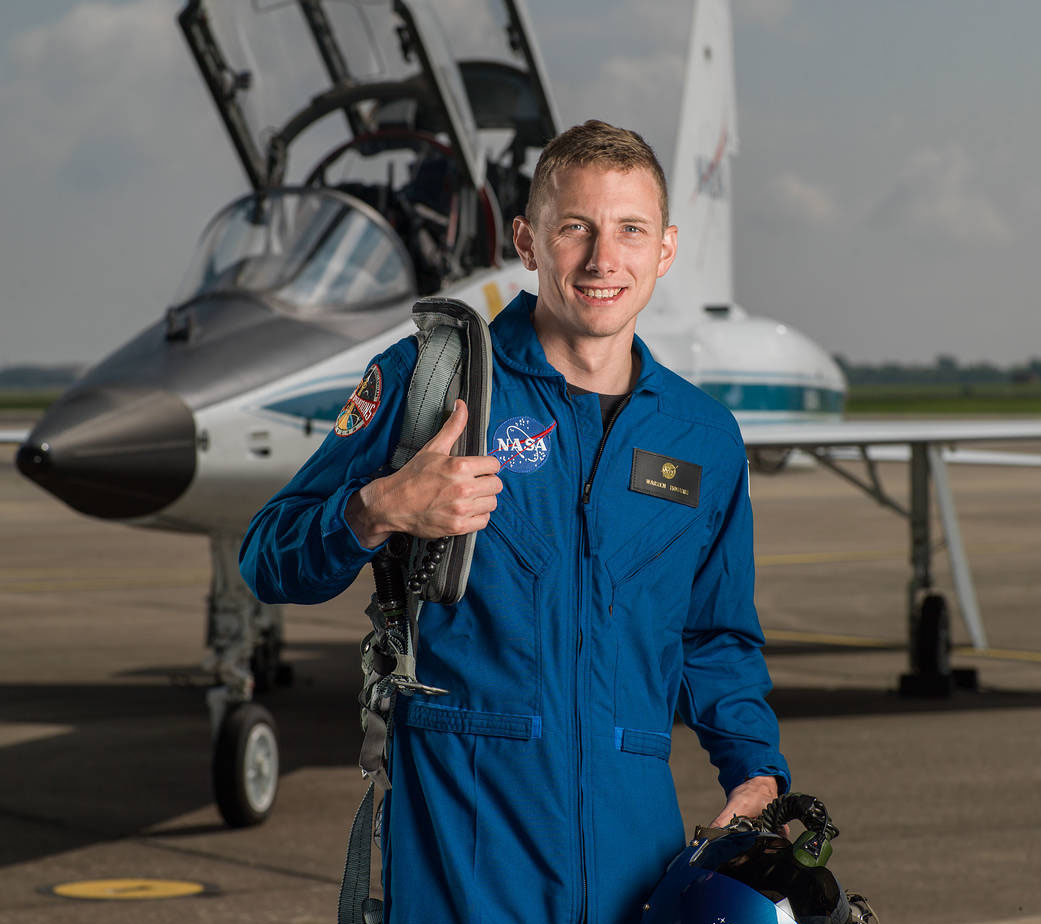
Photo provided by NASA.
Becoming an astronaut
As the Jungle Hawk Owl transitions, so is Hoburg. He formally left MIT this summer, moving to Houston, TX to start his training as an Astronaut Candidate. He said he still informally is available to assist the team if needed, and he continues to follow the project closely.
Becoming an astronaut has been a dream of Hoburg’s since he fi rst started launching rockets as a child, but it wasn’t a dream he thought was realistic.
“It has been in my mind for a long time, but it was also something that I very intentionally never got my heart set on,” said Hoburg. “I very much felt that my probability of getting selected was near zero and so logically it would not make sense to make any plans based on getting selected. I wasn’t going to make big life plans around that, and I wasn’t going to choose what I was working on around that because I wanted to make sure that I was going to be happy and engaged and interested in what I was doing no matter what.”
After applying, Hoburg received a call back for two round of interviews, one in the fall of 2016 and one in the spring of 2017. After what he described as an “incredible experience,” coming to Johnson Space Center and meeting fellow accomplished interviewees, he got the life-changing call that he had been selected to be part of the 2017 Astronaut Candidate class.
“It was extremely surprising to get an interview, and then I was shocked when I got a second interview,” said Hoburg. “But even then when I was down there interviewing and obviously I had a chance at that point, even then, it felt like there was no way it was going to happen. It was absolutely shocking to get the call; it was breathtaking.”
Hoburg began his two-year training program in August 2017. His class includes 14 people, 12 Americans and two Canadians, who will also undergo the same rigorous program to become eligible to be assigned to a space mission.
So far, his training has included two months in Pensacola, Florida, training to fl y the T-6 with the U.S. Navy.
“That is a stepping stone to fl ying the T-38, which is a jet aircraft that NASA fl ies at Ellington Field in Houston,” said Hoburg. “We will be fl ying T-38s for the rest of our careers; NASA uses that for its space-fl ight readiness training. There is a lot of overlap between that aviation environment in a fast-moving jet and the decision-making and resource management that you would need for space flight.”
Soon he will start training for extravehicular activity (EVA) or space walks, in the Neutral Buoyancy Laboratory in Houston.
“It is a large and very deep swimming pool that has a full-scale International Space Station (ISS) mock-up inside of it,” said Hoburg. “So you go underwater in a space suit, you are neutrally buoyant and you are able to practice and learn space walking skills.”
He will also be undergoing Russian language training, robotics training, and ISS systems engineering training.
So far, he is really enjoying the experience.
“The best part honestly is my classmates and the people here,” said Hoburg. “It is such a diverse and wonderful group of people to go through this with.”
Hoburg said that it hasn’t completely sunk in that someday soon he could be up in space. But his perspective has started to change. He recalled a recent trip to the beach in Pensacola at night where he and his fellow Astronaut Candidates were looking up at the moon. It hit him that someday, especially with NASA’s recent discussions about potentially returning, he could go to the moon.
“I was standing there looking up at the moon, and I was just thinking about how it looks a little different now than it used to,” he said. “But I don’t think it really hits you until you are assigned to that first mission to space.”

